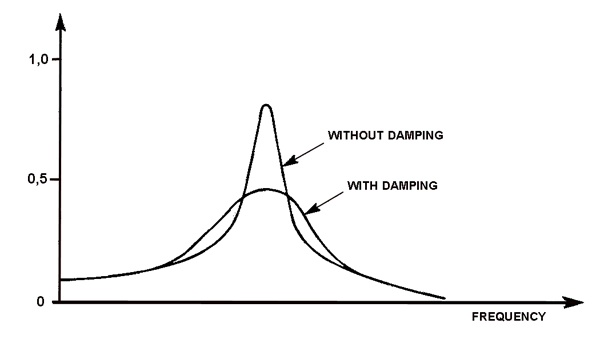
DO THE MATH
When examining a system at resonance, we will observe a maximum peak at the resonant frequency (fO).
The height of the resonant peak will depend on the degree of damping within the vibrating system.
The resonant frequency response can be either very sharp, centered around a high amplitude narrow frequency bandwidth (Δf), or quite broad with lesser amplitude.
The desired acoustical response will determine which characteristic is best.
Systems that have a sharp resonance characteristic are called “high Q”; those with a broad resonance are called “low Q”.
The Q term refers to quality factor and can be calculated by the following equation:
where,
Q = quality factor, unitless
fO = resonance frequency, Hz
f = frequency bandwidth, Hz, taken as the -3 dB down points about the resonant frequency
Figure 6 shows both high Q and low Q resonance response.
RULES OF THUMB
Try to remember the following, or key them into your PDA or computer “cheat sheet.”
– Most everyday sounds we encounter are complex waves comprising many frequencies.
– Simple point sources radiate sound as spherical wavefronts assuming the wavelength is smaller than the source dimensions. At greater distances from the source the wavefronts flatten out and become planar.
– Sounds combine due to the law of superposition and the resultant amplitude depends on the amplitude, frequency, and relative phases of each wave.
– Waves will reflect from room surfaces. Specular reflection requires the wavelength to be at least one-fourth the room surface dimension.
– Resonance is the response of a system when driven at its natural frequency. The sharpness of the resonance will depend on the damping within the system. Rooms have special resonant phenomena called room modes.
Neil Thompson Shade has 30 years of experience in consulting and teaching acoustics, noise control and sound system design. He is president and principal consultant of Acoustical Design Collaborative, Ltd., located in Baltimore, and he has also been taught acoustics, sound system design, computer modeling and related topics at the Peabody Institute of Johns Hopkins University.
Related articles by Neil Thompson Shade:
Acoustic Fundamentals And The Nature Of Sound
Getting To The Basis Of Everything We Hear

